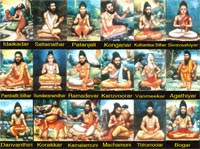On searching about the shelter of Siththars, we come around three different types of information. First is their jeeva samadhi, second one is about the cave they lived and the third one is description about their ashram.
In our previous post on sathuragiri series, when I collected information concerning the shelter of various Siththars, it should be noted that, many were related to the information regarding caves. Moreover it is interesting to consider the fact that all these places lies serially and well interrelated to one another.
This kindle the doubt that, whether these cave were naturally occurred one after another or made out artificially. Recently, in search of some other information among books, I found out some surprising note in Agathiayar’s book titled “Agathiyar Paripooranam”. It is surprising fact that, Siththars are well aware of performing the art of making the artificial caves.
Agathiyar’s concerned poem is as follows:
வாசிநிலை கண்டுசிவ யோகஞ்செய்ய
vaasinilai kandusiva yoganjseyya
மகத்தான புலத்தியமா ரிஷியேகேளு
makaththaana Pulaththiyamaa rishiyaekaelu
பேசவொண்ணா அந்தரங்க உண்மைதன்னை
paesavonnaa antharanga unmaithannai
பெரிதான எக்கியமா முனிதான்சொன்னார்
perithaana ekkiyamaa munithaansonnaar
நேசமுடன் மலைகளிலே குகையுண்டாக்க
naesamudan malaikalilae kukaiyundaakka
நீமகனே மனதுகந்த மலையிற்சென்று
neemakanae manathukantha malayirsenru
பாசமுடன னால்புறமுஞ் சுத்திப்பார்த்து
paasamudan naalpuramunj suththippaarththu
பதிவான யிடமதிலே குகைதான்செய்யே
pathivaana yidamathilae kukaithaanseyyae
குகையறிந்து செய்வதற்கு வகையைக்கேளு
kukaiyarinthu seyvatharkku vakiyaikkaelu
குருவான பூனீரு கல்லுப்போடு
guruvaana pooneeru kalluppoadu
தகையாத கரியுப்பு வெடியுப்யுத்தான்
thakaiyaatha kariyuppu vediyupyuththaan
சார்வான நவாச்சார மன்னபேதி
saarvaana navaachaara mannapaethi
பகையான மலைபேதி மாங்கிசபேதி
pakaiyaana malaipaethi maangisapaethi
பத்தியுள்ள கல்நாதம் கல்மதந்தான்
paththiyulla kalnaatham kalmathanthaan
புகையாத அரபொடியுங் கல்காந்தம்சிங்கிட்டம்
pukaiyaatha arapodiyung kalkaantham sinkittam
புண்ணியனே சரக்குவகை பதிமூன்றாச்சே
punniyanae sarakkuvakai pathimoonraachae
ஆச்சப்பா சரக்குவகை பதிமூன்றுந்தான்
aachappaa sarakkuvakai pathimoonrunthaan
அப்பனே சமபாகம் நிறுத்துக்கொண்டு
appanae samapaakam niruththukkondu
பாச்சப்பா கல்வமதில் பொடித்துநன்றாய்
paachappa kalvamathil podiththunanraai
பருசான யிரும்பினுட தாளிசேர்த்து
parusaana yirumpinuda thaalisaerthu
நீச்சப்பா யானைபரி கத்தம்விட்டு
neechappaa yaanaipari kaththamvittu
நிசமான புலிகரடி ரெத்தம்வார்த்து
nisamaana pulikaradi reththamvaarththu
வாச்சப்பா கொள்ளவித்த தண்ணீர்விட்டு
vaachappaa kollavaththa thaneervittu
மார்க்கமுடன் நவ்வலுட கம்பால்கிண்டே
maarkkamudan navvaluda kampaalkindae
கிண்டிநன்றாய் ரவியில்வைத்து தெளிவைநன்றாய்
kindinanraai raviyilvaiththu thelivainanraai
கிருபையுட னத்தெளிவை மலைமேலூத்த
kirupaiyuda naththelivai malaimaelooththa
சுண்டுநன்றாய்ச் சுவடியது உவடுபோலே
sundunanraaich chuvadiyathu uvadupoalae
சுத்தமுடன் பொங்கியது உப்பாம்பாரு
suththamudan pongiyathu uppaampaaru
கண்டிதமாய் நீருண்டு கல்லுப்புப்போல்
kandithamaai neerundu kalluppoal
கசிந்துமிக உருகுமடா அந்தவேளை
kasinthumika urukumadaa anthavaelai
தொண்டதுபோல் கூந்தாளஞ் செய்துகொண்டு
thondathupoal koonthaalanj seythukondu
திரமாக வெட்டியெடு குகைபோல்தானே
thiramaaka vettiyedu kukaipoalethaanae
தானான உவர்நீரைப் பின்னும்விட்டு
thaanaana uvarneeraip pinnumvittu
தன்மனதுக் கேற்கவே குகைதான்செய்து
thanmanathuk kaerkavae kukaithaanseithu
மானாகேள் குகையதுவும் நன்றாய்ச்செய்து
maanaakael kukaiyathuvum nanraaicheithu
மகத்தான உவர்நீங்க வகையைக்கேளு
makaththaana uvarneenga vakaiyaikkaelu
தேனான மதுஉடனே தண்ணீர்பாலும்
thaenaana mathuudanae thaneerpaalum
சிறுகரந்தைச் சாத்துடனே சேர்ந்துகொண்டு
sirukaranthaich saaththudanae saernthukondu
கோனான குகையைநன்றாய்க் கழுவிப்போட்டால்
koanaana kukaiyainanraaik kazhuvippoattaal
கொடுமையுள்ள உவர்நீங்கித் திறக்கும்பாரே
kodumaiyulla uvarneengith thirakkumpaarae
பாரப்பா யிவ்விதமாய்க் குகைதான்செய்து
paarappaa yivvithamaaik kukaithaanseithu
பத்தியுட னதிலிருந்து தவமேசெய்வாய்
paththiyuda nathilirunthu thavamaeseivaai
நேரப்பா தனித்திருந்து தவமேசெய்தால்
naerappaa thaniththirunthu thavamaeseithaal
நினைவதிலே பாய்ந்துரவி யொளிதான்காணும்
ninaivathilaae paaithnthuravi yolithaankaanum
சாரப்பா தனித்திருந்து ஒளிதான்பார்க்க
saarppaa thaniththirunthu olithaanpaarkka
தலைமலைகள் கெவிகள்வனம் தனில்சென்றார்கள்
thalaimalaikal kevikalvanam thanilsenraarkal
காரப்பா கண்ணொளியைக் கண்ணால்பார்க்க
kaarappaa kannoliyaik kannaalpaarkka
கருத்துறவே தனித்திருந்து கண்ணைப்பாரே
karuthhturavae thaniththirunthu kannaippaarae.
These poems are narrated by Agathiyar to his disciple Pulathiyar, as it is once told by Ekkiyamahaa munivar to Agathiyar, which is a secret truth to do Siva Yoga for knowing vaasi. First the person should go to his favourite hill and roam around to find suitable place where, he can make his own cave.
Take the equal amount of following 13 ingredients viz; pioneer (red coloured water), crystalline salt, kariyuppu, vediyuppu, ammonium chloride, annapaethi, malaipaethi, maangisapaethi, kalnaatham, kalmaththam, arappodi, karkaantham and singittam in kalvam and then grind it well. Then put down the mixture in big iron vessel (called as thaali in Tamil) and pour yaanaiparikantham, blood of pulikaradi and also the boiled water of horsegram. Then place this vessel in sunlight and mix the mixture using twig of jaumoon-lum tree.
After the reminiscent settled down, collect the clear liquid and pour it in the rock where you want to have your cave. After pouring the mixture, the place where the liquid spreads bosoms out and forms into salt. The so formed salt melts down like melting of crystalline salt in water. Now, mark the required area for cave and cut down it.
After cutting down, one can pour the liquid further on rock to get the desired depth. Now rock can be further cut down to deep. Now after achieving the desired structure, Agathiyar also told the way to stop the functioning of that cave further.
Now clean the cave with the equal amount of mixture of honey with water, milk and sirukaranthai extract, which will ultimately, stops the salt formation of cave. After making this cave, be strongly focused and start meditation alone in this cave. Now, mind will become focused to oneness and can view the radiance similar to sunlight on centre of brow. Agathiyar says, for seeing this radiance only, Siththars went forests and also he advises, in order to see that radiance, one should do meditation independently out of human community.
Interesting information! Isn’t it? Our ancestors used the techniques to melt down the rocks rather than cut it down. It will be definitely a marvelous achievement if further technological growth and usages happened in this regard. Our ancestor’s technological solution is not at all inferior compared to nowadays science! Hence, it will be a sorrowful mistake, that we did not upgrade this technological achievement through modern research.
Interested readers can do further research in this regard.
Translated by Lalithambika Rajasekaran

